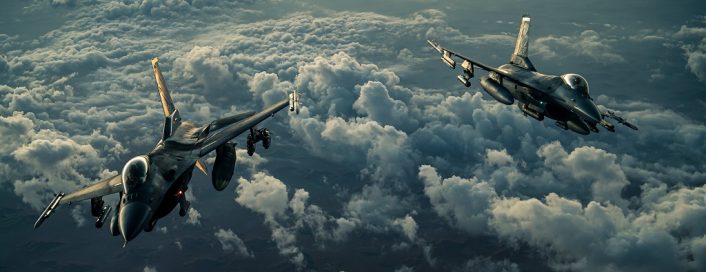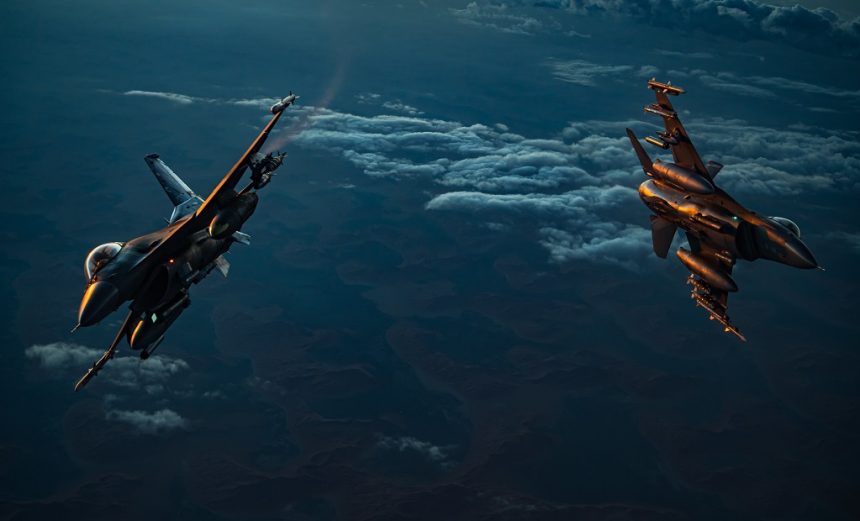The new Electronic Warfare suite will provide the F-16 full-spectrum radar warning, threat identification and advanced countermeasure capabilities against modern EW threats.
The U.S. Air Force selected Northrop Grumman to complete the prototypes for a new Electronic Warfare (EW) suite to be installed on the F-16 Fighting Falcon. According to the press release, the new system will protect pilots from the growing danger of radio frequency-guided weapons by detecting, identifying and defeating advanced threat systems.
“The electronic warfare suite will significantly increase protection to F-16 operators as they execute their missions in increasingly contested environments,” said Ryan Tintner, Vice President for Navigation, Targeting and Survivability at Northrop Grumman. “This system draws on the best of our experience from multiple programs to create an effective and affordable solution to keep the Viper relevant throughout its service life.”
This project should be the continuation of a contract awarded in November 2019, when the Air Force selected L3Harris Technologies and Northrop Grumman to develop and demonstrate prototypes for a new EW suite to improve the protection of the F-16. Working under the SOSSEC Consortium’s Air Force Open System Acquisition Initiative (OSAI) Other Transaction Agreement (OTA), both companies reportedly focused on internally mounted solutions with a digital Radar Warning Receiver (RWR).
According to Northrop Grumman, the new digital EW suite provides full-spectrum radar warning, threat identification and advanced countermeasure capabilities to protect aircrews from modern electromagnetic spectrum threats, by leveraging on an open systems, ultra-wideband architecture for a greater bandwidth which can be mounted internally or in a podded configuration (like the company’s classic AN/ALQ-131 ECM pod).

One interesting aspect that they mentioned is that this EW suite has proven pulse-to-pulse operability with the F-16’s newly acquired AN/APG-83 Scalable Agile Beam Radar (SABR), also built by Northrop Grumman, which has been declared fully operational with the Air National Guard in October 2020. While not better specified, this should mean that the two systems are interoperable without generating significant interferences and maybe, coupled together, the AESA radar and the new EW suite could provide some additional advanced capabilities that would not be available with a mechanical radar.
The fielding of the new radar began in January 2020, following a U.S. Northern Command Joint Emergent Operational Need (JEON) for homeland defense, which could procure up to 372 radars by 2027 if all options are exercised. While the radar is being rapidly fielded, operational testing by the Operational Flight Program Combined Test Force is continuing at Eglin Air Force Base, Florida, to help the operational units to explore the new capabilities and to test and refine the tactics, techniques and procedures (TTPs) being developed for the new radar.
Another point added by Northrop Grumman is that the EW suite being developed for the Viper (as the F-16 is nicknamed by its crews) is part of a product line of electronic warfare capabilities that can be adapted to protect virtually any platform, which shares a common technology baseline with the already known AC/MC-130J Radio Frequency Countermeasures (RFCM).
The AC/MC-130J RFCM, which we reported about in July last year, has been selected by the U.S. Special Operations Command (USSOCOM) to provide threat detection, precision geolocation and active countermeasure capabilities to the AC-130J Ghostrider and MC-130J Commando II and provide Special Operation Forces (SOF) with accurate and timely situational awareness information and improve aircraft survivability.









